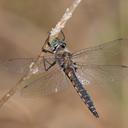United States and Canada
This is a southern coastal species in which males have distinctive caudal appendages. The thorax is diffusely covered with white hairs giving it a characteristically dull appearance. The hindwings may be variously marked with brown basally. The male cerci have a sharp dorsally projecting anteapical spine. The female caudal appendages are 2 mm long.
Size: Total length: 42-45 mm; abdomen: 32-35 mm; hindwing: 29-33 mm.
Similar Species (south-central US): Other baskettails in the region are smaller with narrower abdomens. This the only baskettail with a distinct dorsally projecting tubercle on male cercus.
Habitat: Lakes, ponds and wooded swamps with little flow.
Natural History: This species is uncommon and only sporadically reported in the south-central United States. Sid Dunkle (pers. comm. ) has a single female in his collection from Washington Parish, Louisiana. A single male each was reported by Harp and Harp (1996 ) from Clark County, Arkansas, and by Bick and Bick (1957 ) from Latimer County, Oklahoma (previously reported by Bird (1932a ) as Epitheca canis McLachlan, Beaverpond Baskettail). This species has also only been documented from Houston County within Texas.
Distribution: Southeastern, New Jersey to Oklahoma
Source: Abbott, J.C. 2006-2010. OdonataCentral: An online resource for the distribution and identification of Odonata. Available at OdonataCentral.
Edited by Drew Weber (9/24/2015).
